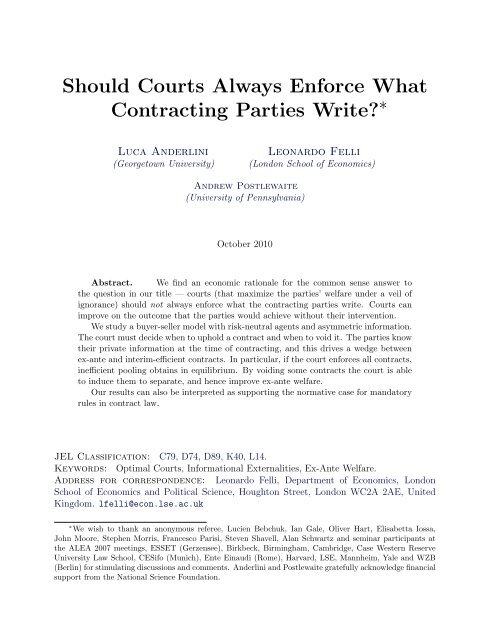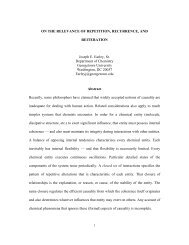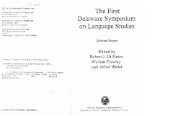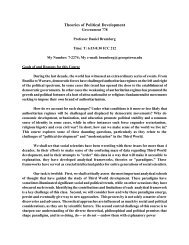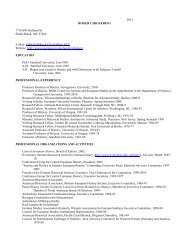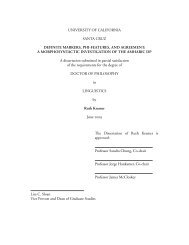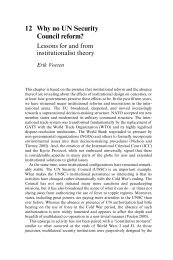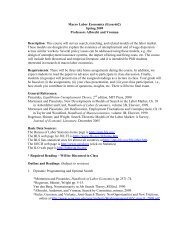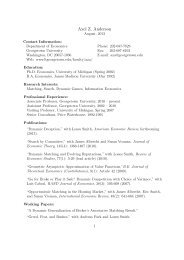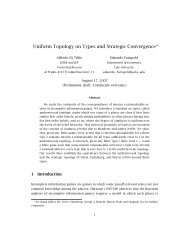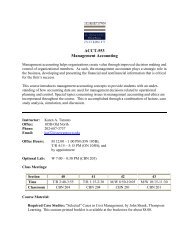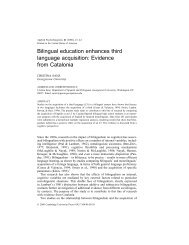PDF File - Georgetown University
PDF File - Georgetown University
PDF File - Georgetown University
You also want an ePaper? Increase the reach of your titles
YUMPU automatically turns print PDFs into web optimized ePapers that Google loves.
Should Courts Always Enforce WhatContracting Parties Write? ∗Luca Anderlini(<strong>Georgetown</strong> <strong>University</strong>)Leonardo Felli(London School of Economics)Andrew Postlewaite(<strong>University</strong> of Pennsylvania)October 2010Abstract. We find an economic rationale for the common sense answer tothe question in our title — courts (that maximize the parties’ welfare under a veil ofignorance) should not always enforce what the contracting parties write. Courts canimprove on the outcome that the parties would achieve without their intervention.We study a buyer-seller model with risk-neutral agents and asymmetric information.The court must decide when to uphold a contract and when to void it. The parties knowtheir private information at the time of contracting, and this drives a wedge betweenex-ante and interim-efficient contracts. In particular, if the court enforces all contracts,inefficient pooling obtains in equilibrium. By voiding some contracts the court is ableto induce them to separate, and hence improve ex-ante welfare.Our results can also be interpreted as supporting the normative case for mandatoryrules in contract law.JEL Classification: C79, D74, D89, K40, L14.Keywords: Optimal Courts, Informational Externalities, Ex-Ante Welfare.Address for correspondence: Leonardo Felli, Department of Economics, LondonSchool of Economics and Political Science, Houghton Street, London WC2A 2AE, UnitedKingdom. lfelli@econ.lse.ac.uk∗ We wish to thank an anonymous referee, Lucien Bebchuk, Ian Gale, Oliver Hart, Elisabetta Iossa,John Moore, Stephen Morris, Francesco Parisi, Steven Shavell, Alan Schwartz and seminar participants atthe ALEA 2007 meetings, ESSET (Gerzensee), Birkbeck, Birmingham, Cambridge, Case Western Reserve<strong>University</strong> Law School, CESifo (Munich), Ente Einaudi (Rome), Harvard, LSE, Mannheim, Yale and WZB(Berlin) for stimulating discussions and comments. Anderlini and Postlewaite gratefully acknowledge financialsupport from the National Science Foundation.
Luca Anderlini, Leonardo Felli and Andrew Postlewaite 11. IntroductionCourts are active players in contractual relationships between economic agents. They routinelyintervene in contractual disputes, excusing performance called for in the contract becauseof intervening events. Yet, in most of modern economic theory courts are treated (oftennot even modeled, but left in the background) as passive enforcers of the will of the partiesembodied in their contractual agreements.This simplistic view of the role of courts stems from the fact that in a world with completecontracts, to behave as a passive enforcer is clearly the best that a court that is interested inmaximizing contracting parties’ welfare can do. In the “classical” world of modern economictheory, contracts are complete.In a world in which complete contracts are not feasible it is no longer obvious that a courtshould be a passive enforcer, and in fact it is no longer true. For example, the contractingparties may face some uninsurable risk and the court may improve their welfare if it is ableto use some information available ex-post and excuse performance in some eventualities. 1Once the way for an active court is open, a host of related questions naturally arise. Theaim of this paper is to address the following one. Suppose that the court cannot condition(ex-ante or ex-post) on any variable that cannot be contracted on by the parties themselves.Is it then the case that the court’s intervention can play any welfare-enhancing role?The answer to the question above is “yes” if the parties are asymmetrically informed atthe time they contract and the court maximizes their ex-ante welfare, that is, their expectedwelfare before either party gets information not available to the other. Asymmetry in theparties’ information at the time they contract can lead to a “lemons-like” situation in whichadverse selection leads to inefficient contracts. Courts that do not simply enforce contractsas they are written can sometimes ameliorate the inefficiency that results from asymmetricinformation.We provide an example in which this is indeed the case. We also derive the optimaldecision rule for an active welfare-maximizing court. This rule implies that the court inequilibrium voids contracts that the contracting parties, at the contracting stage, would likethe court to enforce.1 This is the case, for example, in Anderlini, Felli, and Postlewaite (2007).
Luca Anderlini, Leonardo Felli and Andrew Postlewaite 3be settled; instead, courts decide after they know the details of the dispute. Nevertheless,over time the accumulated decisions that courts have made in a broad array of cases createsa set of precedents that shape how future disputes will be settled. The rule of precedents(stare decisis) guarantees that a court, when asked to rule on a dispute is bound, at least tosome extent, by the ruling implied by the accumulated precedents. 3 Rather than model thisgradual evolution of the way contractual disputes are resolved we treat the court as choosing,once and for all, an optimal rule. 4Our aim is not to suggest that there is an easy rule that courts can apply to void particularcontracts that come before them. Indeed, in the example below, a court would needsubstantial detail of the parties’ circumstances to know precisely when contractual performanceshould be excused. Rather, the central point is that there are circumstances in whichvoiding contracts that parties would like the court to uphold can be welfare enhancing.It is clear that our arguments apply equally well to legislators choosing whether to imposeany mandatory rules in contract law. That these rules will be anticipated by the partiesis trivial in this case. Equally clear is the fact that our arguments above also constitute acompelling case for the fact that the normative role of legislators should be that of maximizingthe parties’ ex-ante welfare. 5In our view, the key difference between these two interpretations is informational. Ourresults show that court intervention is optimal in some cases. In just the same way, mandatoryrules will be welfare-enhancing when aimed at some subset of contracting parties but notwhen aimed at others. It seems likely that, especially in a regime of “case law,” courts will beable to better tailor their intervention to the class of cases that needs it than the legislators.Statute books are changed less often than cases are ruled on by courts, and the informationavailable to legislators is less sensitive to the heterogeneity of characteristics of the pool ofcases that the courts review.3 The definition of stare decisis from the Wex on-line legal dictionary and encyclopedia at the Law Schoolof Cornell <strong>University</strong>, (http://www.law.cornell.edu/wex/index.php/Stare decisis) reads as follows:“Latin for ‘to stand by things decided.’ Stare decisis is essentially the doctrine of precedent. Courts cite tostare decisis when an issue has been previously brought to the court and a ruling already issued. Generally,courts will adhere to the previous ruling, though this is not universally true.”4 See Anderlini, Felli, and Riboni (2010) for a paper that explicitly models the dynamic evolution ofprecedents and its implications for the efficiency of court rulings.5 The role of legislators in shaping mandatory rules is also clearly akin to the role of regulators in certainmarkets.
Should Courts Always Enforce What Contracting Parties Write? 4Throughout the paper, we give more emphasis to the interpretation of our results concerningcourt intervention as opposed to mandatory rules because of this last consideration.Nevertheless, we believe that our results are useful in both guises.1.1. The Role of Courts in Promoting Disclosure of InformationOur aim is to highlight how the rules that courts use in adjudicating contractual issuescan potentially increase the information available to contracting parties, and consequently,affect the parties’ welfare. Historically, courts have had an interest in promoting disclosureof information at least since the English case of Hadley vs. Baxendale in 1854. 6 The courtheld in that case that a defendant who breached a contract was liable only for damages thatmight reasonably have arisen given the known facts rather than the higher damages that wereactually suffered because of circumstances known only to the plaintiff. As argued in Adler(1999), the limitation on damages implicit in the Hadley rule is a default that is often viewedas promoting disclosure: “A party who will suffer exceptional damages from breach need onlycommunicate her situation in advance and gain assent to allowance so that the damages areunmistakably in the contemplation of both parties’ at the time of contract.” 7 The discussionof the role of courts in promoting information disclosure, to our knowledge, focusses primarilyon the benefit of disclosure to the contracting parties. In the absence of disclosure, resourceswill be wasted in writing needless waiver clauses and inefficient precaution.Courts will have an interest in promoting disclosure of information in our model, but fora very different reason, and with very different consequences. Courts will affect the amountof information that is revealed by informed parties through their treatment of contractsthat reveal little information. While contracts may reveal little information simply becausethe parties have little information, courts will treat such contracts more harshly than theyotherwise might because of the incentive effects such treatment will have on informed parties.Those with relevant information will reveal it in order that courts will more likely enforce theagreements that are made. Thus, courts are not examining a contract brought before themsolely to uncover the parties’ intent. They also take into consideration how the treatment ofthe contract will affect contracting parties different from the parties before them but affected6 9 Exch. 341, 156 Eng. Rep. 145. (Court of Exchequer, 1854).7 See also Ayres and Gertner (1989) and Bebchuk and Shavell (1991) for a discussion of the Hadley ruleand its role in promoting disclosure of information. See Maskin (2006) for a critical view.
Luca Anderlini, Leonardo Felli and Andrew Postlewaite 5by the court’s ruling via precedents.In this paper, the Court (or the legislature, as discussed above) achieves its goal of enhancingefficiency by means of anticipated actions that are akin to “mandatory” or “immutable”rules; rules that the contracting parties cannot modify at the negotiation stage. These rulesneed to be mandatory given the conflict of interest, described above, between the objectivesof the parties at the contracting stage and the court’s objectives. Interestingly, in the extantliterature the discussion of Hadley vs. Baxendale, on the other hand, has mainly focusedon the use of “default” rules, rules that apply only in the absence of explicit contractualprovisions by the parties.1.2. Related LiteratureIn Section 2 of their Chapter for the Handbook of Law and Economics (Polinsky and Shavell,2007), Hermalin, Katz, and Craswell (2007) offer a systematic and comprehensive review ofthe existing literature presenting arguments “for” and “against” the “freedom of contract.”This paper is a contribution to this literature, presenting a robust set of circumstances inwhich the case “against” the “freedom of contract” (interpreted in its broadest sense) prevails.Their systematic and authoritative survey discusses the roles of traditional (third-party)externalities, asymmetric information, market power, bounded rationality, and distributionalfairness as possible set ups for the case in favor of restricting the parties’ freedom to contractat will. Our contribution is one that reinforces the case for such partial restrictions based onasymmetric information.There is a growing literature that explicitly models the role of courts in contractualrelationships. In a moral-hazard set-up, Bond (2009) analyzes optimal contracting betweenparties when judges can impose an outcome other than the contracted outcome in exchange fora bribe. Bond shows that in a simple agency model, this possibility will make the contractingparties less likely to employ high-powered contracts. Usman (2002) also focuses on a moralhazardenvironment. He lays out a model in which contracts contain variables that arenot observable to courts unless a rational and self-interested judge exerts costly effort. Hisanalysis concentrates on contracting behavior and the incentive to breach when judges valuethe correct ruling but dislike effort. Levy (2005) analyzes the trade-off that arises when thejudge in ruling on a dispute is, at the same time, trying to influence the perception of thepublic (or an evaluator) about his own ability. This trade-off can induce the judge to distort
Should Courts Always Enforce What Contracting Parties Write? 6his decision to avoid his decision being appealed and possibly reversed.The courts in these papers are governed by a judge who maximizes his or her personalutility. In contrast to these papers, there is a literature that analyzes courts that maximize theexpected welfare of the contracting parties. Posner (1998) analyzes whether a court shouldconsider information extrinsic to the contract in interpreting the contract. Closer to thecurrent paper, Ayres and Gertner (1989) and Bebchuk and Shavell (1991) analyze the degreeto which courts’ interpretation of contracts affect incentives to reveal private information.The focus of this work is the effect of different court rules regarding damages for breach ofcontract on the incentives for parties to disclose information regarding the costs of breach atthe time of contracting. Shavell (2006) presents a general examination of the role of courtsin interpreting contracts.The present paper analyzes the role of a welfare-maximizing court that can affect thetype of contracts that are written by excusing performance (voiding the contract) in somecircumstances. The possibility of welfare improvements are a consequence of the effect of thecourt’s rules for enforcing contracts on the parties’ incentives to reveal private information.Our paper differs from Ayres and Gertner (1989), and Bebchuk and Shavell (1991) in thatwe focus on the externality that informed contracting parties may impose on uninformedcontracting parties, which is absent from these papers. In fact in both of these contributions,the welfare gains from information disclosure stem from the fact that once information isdisclosed a different action can be implemented by one of the contracting parties. 8 Bycontrast, in this paper, failure to disclose leads to a transaction with negative surplus beingexecuted which is to the advantage of the “bad type” of one of the contracting sides (seller),but decreases overall welfare at the same time.In different contexts, several papers have made the point that in the presence of asymmetricinformation inefficiency may arise (Aghion and Hermalin, 1990, Hammond, 2005, Spier,1992). These papers show that cream skimming (Hammond, 2005) and in general, the incentiveto signal private information can yield inefficient (and possibly incomplete) contracts(Spier, 1992) and hence welfare can be enhanced by limiting (by means of the law or regulations)these signalling possibilities (Aghion and Hermalin, 1990). Our paper differs from8 In both cases, this is the level of effort of one of the parties; specifically the level of “care” exercised byBaxendale in Hadley vs. Baxendale — see footnote 6 above.
Luca Anderlini, Leonardo Felli and Andrew Postlewaite 7this branch of the literature in that in our environment the inefficiencies arise because of thelack of disclosure of private information, rather than a tendency to inefficiency-generatingsignaling. Our Court, by not enforcing certain contracts, may enhance ex-ante efficiency byfacilitating and not hampering the disclosure of private information.A paper that similarly addresses the role of a court in dealing with contractual issuesis Schwartz and Scott (2003). In that paper the authors advocate a Commercial Law thatdiffers from current US arrangements in three main respects. When disciplining trade betweensophisticated parties in the absence of any externalities, Commercial Law should limitconsiderably the use of default rules (rules that apply in the absence of explicit prescriptionsby the contracting parties). The rationale for this prescription is that general default rulessimply increase the transaction costs faced by the sophisticated contracting parties. Moreover,Contract Law should limit any ambiguities in the way contractual clauses are enforced,and therefore minimize the chances of having to resort to a Court’s (uncertain) interpretationof existing rules. Finally, Commercial law should specify no “mandatory” or “immutable”rules that the parties cannot change.Clearly the prescriptions in Schwartz and Scott (2003) differ substantially from the conclusionswe draw in this paper. In the environment we describe, in the presence of sophisticatedbut asymmetrically informed parties mandatory rules might be desirable; they are welfareenhancing.The literature on mandatory rules is large, and we refer the reader to the comprehensivecontribution of Hermalin, Katz, and Craswell (2007). Perhaps the most prominent advocateof the absence of mandatory rules is Posner (2003), who argues that contract theory cannotprescribe “universally” useful contractual prohibitions, and hence, the case against mandatoryrules is sealed. Craswell (2003) on the other hand persuasively (in our view) argues that thefact that contract theory is unable to offer “universal” conclusions does not imply that, onbalance, across a pool of heterogeneous cases, mandatory rules may not be justified. Hermalinand Katz (1993) argue that, in general mandatory rules will not have beneficial effects whencontracting takes place in a “screening” set up. Their conclusion is of course consistent withthe main message coming out of the literature on wasteful signaling that we discussed above.Lastly, the welfare enhancing court intervention (or mandatory rule, or regulation) thatwe identify here is to impose a price-cap in some cases. The literature on price caps goes
Should Courts Always Enforce What Contracting Parties Write? 8back a long way in Industrial Organization, with arguments for and against price caps as, forexample, a way to contain the effects of market power.It is beyond the scope of this paper to survey this field, and the reader is referred totextbooks such as Clarkson and Miller (1982), Tirole (1988), Carlton and Perloff (1994) ormore recently Bellflamme and Peitz (2010). It is interesting to note that our results supporta welfare-enhancing role for price-caps in a context with asymmetric information. This seemsto be novel as far as we are aware. In contrast to our results, Earle, Schmedders, and Tatur(2007) find that under conditions of price uncertainty price-caps can have important negativewelfare effects.2. A Simple Example2.1. BasicsOur central point can be made via a simple example. 9 There are a buyer B and a seller S,with a single indivisible object (a “widget”) potentially available for trade.The seller has private information at the time of contracting. He knows his type, whichcan be either b(ad) or g(ood). Each type is equally likely, and the buyer does not know S’stype.Depending on S’s type the value and cost of the widget are either v b and c b or v g and c grespectively. A seller of type b is “bad news” in two ways. First, the cost of the widget ishigher. Second, while the surplus for a good seller is positive, it is negative when the selleris bad. In other words, we assume thatc g < c b and v b − c b < 0 < v g − c g (1)To make the model interesting we also assume thatv b + v g2> c b (2)which of course — together with (1) — implies that expected surplus is positive.9 We refer the interested reader to our working paper (Anderlini, Felli, and Postlewaite, 2006) for a richermodel that allows some additional points to be brought to the fore. In particular, our set up here does notallow us to focus on the possibility that an ambiguous Court may also be welfare improving. We return tothis point in Section 3 below.
Luca Anderlini, Leonardo Felli and Andrew Postlewaite 9The informed seller makes a take-it-or-leave-it offer of a price p to the uninformed buyer. 10The buyer then accepts or rejects. If the offer is rejected both earn a payoff of zero.2.2. CourtsAs we mentioned above, our courts are Stackelberg leaders. They announce which contractswill be enforced and which will be voided. To see specifically what effects a voiding rule willhave on the equilibrium of the model, we need to specify the — off-the-equilibrium-path asit turns out — payoffs associated with contracts that the court will void.Suppose that the seller offers a contract that the court has announced it will void, possiblywith a buyer who accepts the offer. What are the correct payoffs to the parties in thiscase? Obviously there is considerable latitude in specifying these values. One could imaginepenalties for offering and/or accepting the contract. Or a seller who winds up with positiveprobability delivering the widget — and thus incurring the cost — but, not having recourseto a court, unable to exact the payment from the buyer. Further, we could imagine relationshipspecific ex-ante investments that are not recouped once the contract is voided andrenegotiation takes place. 11Our results below are robust to the precise specification of payoffs associated with a voidedcontract. They remain true provided that offering a contract that is accepted and then voidedby the court is no better than no transaction at all as far as the seller is concerned. In otherwords, it is sufficient that somehow a contract that is voided by the court prevents trade fromtaking place.10 Extreme bargaining power in favor of the informed seller greatly simplifies the analysis. Results with thesame flavor can easily be obtained in situations with intermediate bargaining power. What seems importantis that the bargaining power should not reside entirely with the uninformed side.11 As in Anderlini, Felli, and Postlewaite (2006) a relationship-specific ex-ante investment could yield notrade when the court voids the contractual agreement. Assume, for simplicity, that while the seller has all thebargaining power at an ex-ante stage if the contract is voided and parties trade ex-post the bargaining powershifts to the buyer. Then postulate a relationship-specific investment stage in which the informed seller caninvest or not, with the trade surplus vanishing if S does not invest. If the contract is voided by the court,the parties then enter a renegotiation stage in which the buyer has all the bargaining power so he makes atake-it-or-leave-it offer to the seller. This clearly will expropriate any surplus the seller may have enjoyed(his investment is sunk at that stage) implying that if the seller expects the court to void the contract he willnot invest and hence trade will not occur. We do not make explicit the formalities of this “addition” to themodel since they are straightforward and do not add much to the intuitive outline we have just given here.
Should Courts Always Enforce What Contracting Parties Write? 102.3. Equilibrium With A Passive CourtAs we suggested above, when all contracts are enforced inefficient pooling can obtain inequilibrium. When the value of the good widget, v g , is sufficiently high, there will typicallybe multiple pooling equilibria in which both types of seller offer the same price. When theseller types pool, the buyer will not know which type of widget is being offered, and will valueit at the average of the values of the good and bad widget. As long as the price offered bythe seller is below this average value, the buyer will accept the offer. The optimal poolingcontract for the seller is than one in which the price at which the widget is offered, p, is theaverage value: (v g + v b )/2, since any offer at a higher price will be rejected.There may also exist a separating equilibrium in which the two types of seller offer differentprices, p g ≠ p b and in doing so they reveal their type. When the prices offered by the twotypes of seller differ, the buyer will not accept the offer at price p b if p b > v b . Since v b < c b ,any price p b at which the buyer would be willing to buy would result in a loss for the seller.Hence, for there to be a separating equilibrium with different prices offered by the two typesof sellers, the buyer must reject the offer from the bad seller, which results in a payoff of 0to that seller. This can be optimal for the bad seller if p g ≤ c b ; in this case, the price offeredby the good seller is less than or equal to the cost of the bad seller, and consequently thebad seller cannot gain by offering the good seller’s price p g . We have assumed that c g < c b ,so there can be separating equilibria in which the two types offer prices p g ≠ p b , p g ∈ [c g , c b ],with the buyer accepting the offer at p g and rejecting the offer at p b . 12The payoff is 0 to the bad seller in any separating equilibrium, while the payoff to the goodseller in any separating equilibrium is obviously highest when p g = c b . If (v g + v b )/2 > c b , theoptimal pooling equilibrium described above is the best possible equilibrium for both typesof seller. We summarize this argument in the following proposition.Proposition 1. Equilibrium with a Passive Court: Suppose the court enforces all contracts.For v b sufficiently large, there is a unique equilibrium that is optimal for both types of sellerin which they pool in offering to trade at the same price p = (v b + v g )/2. 1312 If the buyer’s beliefs are that prices other than p b and p g are offered by a bad seller, offers at these priceswill be rejected.13 We focus on the equilibrium in this example that is optimal for both types of seller because it is eminentlyplausible. We should note, however, that it is the unique equilibrium in this example that satisfies theundefeated refinement criterion. (See Mailath, Okuno-Fujiwara, and Postlewaite (1993)).
Luca Anderlini, Leonardo Felli and Andrew Postlewaite 11A pooling equilibrium in which the buyer is accepting the offer from both types of selleris clearly inefficient. The expected surplus in this case is equal toW P = v b − c b + v g − c g2(3)which, by (1) is obviously lower than what expected surplus would be in a first best scenarioin which trade takes place if and only if S is of type g. In this case, expected surplus wouldbeW F = v g − c g2(4)2.4. Equilibrium With An Active CourtWe now consider a court that actively intervenes and voids some contracts. In so doing thecourt will be able to induce separation between the two types of seller and increase expectedwelfare. The court can adopt a simple policy of voiding “extreme” contracts by imposing aprice cap. This will rule out the range of prices at which the bad seller wants to pool, thusforcing separation, and hence preventing the sale from taking place when the seller is bad.This, as we remarked above, will raise expected surplus from W P , as in (3), to W F , as in (4).Proposition 2. Equilibrium with an Active Court: Assume the court announces that it willvoid all contracts with a price p exceeding some price cap p such that c g ≤ p < min{v g , c b }.Then there is a unique equilibrium payoff that weakly Pareto dominates all other equilibriumpayoffs for both types of seller. This payoff is obtained when the two types of seller separate:the good seller offers a price p and the bad seller does not transact.Suppose that we have a pooling equilibrium at an offered price p = p b = p g ≤ p. Sincep < c b , the bad seller will have a negative payoff if the offer is accepted. He can do betterby not trading, which he can accomplish by setting a sufficiently high price. Hence, the onlypossibility of a pooling equilibrium at which p is offered by both types of seller must involvethe buyer refusing.There will be separating equilibria in which the good seller announces a price p g ∈ (c g , p]and the bad seller does not trade (say, but announcing a price p b > v g ). 14 Since p g > c g14 We assume that any other offered price is believed to come from the bad seller.
Should Courts Always Enforce What Contracting Parties Write? 12assures that the good seller has a positive payoff at this price, p g ≤ p guarantees both thatthe seller will accept the offer and the court will not void the contract, and p g ≤ c g assuresthat the bad seller cannot get a positive payoff by replicating the good seller’s offer.Thus, when the court uses this rule to void contracts, the bad seller cannot obtain a positivepayoff at any equilibrium. The unique equilibrium payoff that weakly Pareto dominatesall other equilibrium payoffs entails the good seller setting p g = p and the bad seller nottrading.3. ConclusionWhen contracting parties are asymmetrically informed a benevolent court, that maximizesthe parties’ ex-ante welfare, can enhance efficiency by voiding certain aspects of the contractthat the parties at the negotiation stage would like the court to uphold. In particular, ourexample above shows that the court can accomplish this by voiding extreme contracts: tradingcontracts that specify very high prices.In a more general setting the welfare enhancing role of the court can take different formsof intervention. For example in Anderlini, Felli, and Postlewaite (2006) the court can enhanceefficiency by voiding the trade of a specific widget whatever the specified price. Moreover,efficiency can be further increased if the court’s intervention does not occur with certainty.In other, words the incentives of the informed party to reveal his private information at thenegotiation stage are enhanced by the mere possibility (but not necessarily the certainty)of the court’s intervention. In Anderlini, Felli, and Postlewaite (2006) this is achieved bythe court committing, at the ex-ante stage, to randomize with a given probability betweenvoiding and upholding the trade of a given widget. The randomizing behavior of a court mayappear at first glance an unrealistic one. We do not think so. Indeed, in order to create theright incentives to the parties to disclose the relevant private information it is enough thatthe existing body of precedents is ambiguous enough to lead the parties to believe that therelevant aspect of the contract will be voided by the court with the desired probability. Itis undeniable that in reality laws and the body of precedents are sufficiently ambiguous inmany cases.Our main result (Propositions 1 and 2) can be viewed as identifying a kind of “secondbest” phenomenon in an incomplete contract world. We start with a model in which somedegree of contractual incompleteness is assumed (the costs and values of each widget are not
Luca Anderlini, Leonardo Felli and Andrew Postlewaite 13verifiable and hence not contractible). In this world it is in fact welfare-improving to imposefurther incompleteness by making some contracts effectively impossible in equilibrium. Thisis what our active court does. This is similar to the finding in Bernheim and Whinston(1998) that under some conditions, when one assumes that contracts are exogenously coarse,equilibrium contracts may be even coarser than the constraints impose. However, our mainresult differs from theirs in that it does not assert that contracts will be coarse (or incomplete)in equilibrium. Rather it asserts that imposing further incompleteness can increase expectedwelfare.We conclude by remarking again that the prescriptions we have derived that pinpointhow active courts should intervene can also be interpreted as telling us how mandatory rulesshould be designed. This paper is, in a sense, agnostic about this. In either case we identifythe welfare enhancing role of an ex-ante commitment to void certain aspects of a contract.Whether we can interpret our results as indicating a role for active courts or a role formandatory rules depends on whether the rule that the Court commits to is the result of anaccumulated body of precedents (it is case law) or instead is part of a statute designed by alegislator. As we noted in the introduction, the information on which the court can conditionits intervention is likely to be finer than that available to the legislators designing mandatoryrules.ReferencesAdler, B. E. (1999): “The Questionable Ascent of Hadley v. Baxendale,” Stanford LawReview, 51(6), 1547–1590.Aghion, P., and B. Hermalin (1990): “Legal Restrictions on Private Contracts CanEnhance Efficiency,” Journal of Law, Economics and Organization, 6, 381–409.Anderlini, L., L. Felli, and A. Postlewaite (2006): “Should Courts Always EnforceWhat Contracting Parties Write?,” <strong>University</strong> of Pennsylvania, Institute for Law &Economics Research Paper No. 06-24.(2007): “Courts of Law and Unforeseen Contingencies,” Journal of Law, Economics,& Organization, 23, 662–684.Anderlini, L., L. Felli, and A. Riboni (2010): “Why Stare-Decisis?,” London Schoolof Economics mimeo.
Should Courts Always Enforce What Contracting Parties Write? 14Ayres, I., and R. Gertner (1989): “Filling Gaps in Incomplete Contracts: An EconomicTheory of Default Rules,” Yale Law Journal, 87.Bebchuk, L., and S. Shavell (1991): “Information and the Scope of Liability for Breach ofContract: The Rule of Hadley V. Baxendale,” Journal of Law, Economics & Organization,7, 284–312.Bellflamme, P., and M. Peitz (2010): Industrial Organization: Markets and Strategies.Cambridge U.K.: Cambridge <strong>University</strong> Press.Bernheim, D., and M. Whinston (1998): “Incomplete Contracts and Strategic Ambiguity,”American Economic Review, 88, 902–932.Bond, P. (2009): “Contracting in the Presence of Judicial Agency,” The B.E. Journal ofTheoretical Economics (Advances), 9(1)(article 36).Carlton, D. W., and J. M. Perloff (1994): Modern Industrial Organization. New York,NY: Harper Collins.Clarkson, K. W., and R. L. Miller (1982): Industrial Organization: Theory, Evidenceand Public Policy. Mew York NY: McGraw-Hill.Craswell, R. (2003): “In that Case, What is the Question?,” Yale Law Journal, 112,903–924.Earle, R., K. Schmedders, and T. Tatur (2007): “On Price Caps Under Uncertainty,”Review of Economic Studies, 74, 93–111.Hammond, P. (2005): “Efficiently Regulated Competition in Economies with Adverse Selection,”Stanford <strong>University</strong> mimeo.Hermalin, B. E., A. W. Katz, and R. Craswell (2007): “Contract Law,” in Polinskyand Shavell (2007), chap. 1.Hermalin, B. E., and M. L. Katz (1993): “Judicial Modification of Contracts betweenSophisticated Parties: A More Complete View of Incomplete Contracts and Their Breach,”Journal of Law, Economics, & Organizationand Organization, 9, 230–255.Levy, G. (2005): “Carrierist Judges and the Appeals Process,” Rand Journal of Economics,36, 275–297.
Luca Anderlini, Leonardo Felli and Andrew Postlewaite 15Mailath, G. J., M. Okuno-Fujiwara, and A. Postlewaite (1993): “Belief basedrefinements in signaling games,” Journal of Economic Theory, 60, 241–276.Maskin, E. (2006): “On the Rationale for Penalty Default Rules,” Florida State <strong>University</strong>Law Review, 33(3), 557–562.Polinsky, M. A., and S. Shavell (eds.) (2007): Handbook of Law and Economics, vol. I.Amsterdam: Elsevier Science Publishers.Posner, E. (1998): “The Parol Evidence Rule, The Plain Meaning Rule, and the Principlesof Contractual Interpretation,” <strong>University</strong> of Pennsylvania Law Review, 146, 533–577.Posner, R. A. (2003): Economic Analysis of Law. 6 th edn. Boston: Little, Brown & Co.Schwartz, A., and R. E. Scott (2003): “Contract Theory and the Limits of ContractLaw,” Yale Law Journal, 113, 541–619.Shavell, S. (2006): “On the Writing and Interpretation of Contracts,” Journal of Law,Economics, & Organization, 22, 289–314.Spier, K. E. (1992): “Incomplete Contracts and Signalling,” RAND Journal of Economics,23, 432–43.Tirole, J. (1988): The Theory of Industrial Organization. Cambridge, Massachusetts: MITPress.Usman, K. (2002): “Verifiability and Contract Enforcement: A Model with Judicial MoralHazard,” Journal of Law, Economics & Organization, 18, 67–94.


